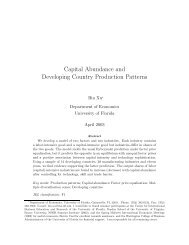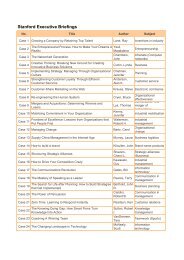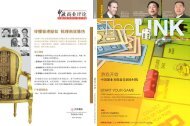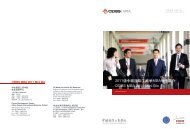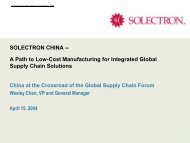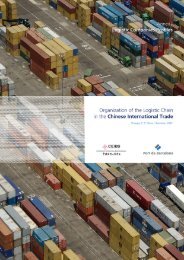Untitled - China Europe International Business School
Untitled - China Europe International Business School
Untitled - China Europe International Business School
Create successful ePaper yourself
Turn your PDF publications into a flip-book with our unique Google optimized e-Paper software.
Organization of the logistic chain in the Chinese international trade<br />
V.3. The main players in the logistic chain<br />
Shippers and consignees<br />
The trend in <strong>China</strong> towards more high-value manufacturing and the increasing competition to lower<br />
costs at a global scale will drive the logistic outsourcing requirements for the shippers in <strong>China</strong> and the<br />
customers in <strong>Europe</strong>. Speed to market, more sophisticated logistic services, a more reliable and<br />
flexible logistic chain and less fragmentation in the flow of information and money are some of the<br />
cargo owners increasing requirements.<br />
Speed to market<br />
Shippers producing in or sourcing from <strong>China</strong> agree about the fact that the time required for a product<br />
sourced or produced in <strong>China</strong> to reach the <strong>Europe</strong>an market is currently too long and needs to be<br />
reduced. This requirement becomes especially critical in some sectors and lead to use air<br />
transportation.<br />
� For a <strong>Europe</strong>an retailer sourcing in <strong>China</strong>, from placing an order to reach the store, a product<br />
needs more than 100 days. If the sourcing process of choosing a supplier, sending samples,<br />
quality control, etc. is taken into consideration, then the whole process can last for more that one<br />
year.<br />
� In the consumer electronics sector, products with a high volatility price, and fast obsolescence<br />
after being launched, are shipped to <strong>Europe</strong> by air to reach the speed required.<br />
Logistic chain’s integration<br />
More and more customers in <strong>Europe</strong> are demanding door-to-door services to the manufacturing<br />
companies in <strong>China</strong>. Therefore, companies in <strong>China</strong> have shift from dealing with several logistic<br />
providers, usually their customers’ freight forwarder, to look for a contract with one global and<br />
comprehensive logistic provider who can manage the whole logistic chain for their exports from <strong>China</strong><br />
to <strong>Europe</strong>. This global operator can be an international forwarding company (Kuehne&Nagel,<br />
Panalpina, Exel, etc…) as well as global intermodal companies (Maersk, …). The main requirement is<br />
to take care of all the necessary range of services to handle the flow of exports between the<br />
manufacturing site in <strong>China</strong> and the customers in <strong>Europe</strong>. A comprehensive network within <strong>Europe</strong> is a<br />
must. However an important presence in <strong>China</strong> is also required to ensure a smooth communication<br />
and easy the shipments’ follow-up in the Chinese part of the logistic chain. A reputation of good service<br />
in <strong>Europe</strong>, financial advantages and Chinese market know-how are also quoted by the companies<br />
interviewed as important issues in the selection of this kind of Logistic provider.<br />
Building direct-to-shop delivery containers<br />
For certain industries like retail or garment, freight forwarders and 3PL’s are starting to build logistic<br />
platforms in <strong>China</strong> to consolidate cargo and build containers to delivery directly to stores. Consolidating<br />
and performing specialized value added services (labeling, CQ, ironing, etc...) in <strong>China</strong> eliminate<br />
deconsolidation at destination in <strong>Europe</strong> creating a cost advantage.<br />
CEIBS Port of Barcelona Chair of Logistics 58



